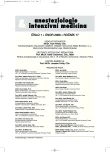Antifibrinolytic agents in off-pump cardiac surgery: analysis of blood loss, safety and cost-effectiveness
Antifibrinolytika u kardiochirurgických operací bez mimotělního oběhu – analýza krevních ztrát, bezpečnosti a efektivity nákladů
Cíl studie:
Porovnat hemostatické účinky antifibrinolytik (tranexamové kyseliny, aprotininu) a placeba u revaskularizačních operací myokardu bez mimotělního oběhu a zhodnotit vliv této terapie na efektivitu nákladů.
Typ studie:
Prospektivní, randomizovaná, dvojitě slepá studie.
Název a sídlo pracoviště:
3. LF UK a FNKV, Praha.
Materiál a metoda:
Do studie bylo zařazeno 100 pacientů, hodnoceno bylo 91 nemocných (skupina A, n = 32, tranexamová kyselina 1 g do kožního řezu a dále kontinuálně 200 mg/h; skupina B, n = 29, aprotinin 1000 000 m. j. do kožního řezu a dále 250 000 m. j./h; skupina C, n = 30, placebo).
Výsledky:
Vysoce signifikantní rozdíly mezi skupinami byly nalezeny v kumulativních krevních ztrátách za 4 h (geometrické průměry [95% intervaly spolehlivosti] – skupina A: 89,3 ml [72,7 ml; 109,8 ml], skupina B: 72,3 ml [49,2 ml; 106,3 ml] a skupina C: 192,3 ml [151,8 ml; 243,5 ml]) (p < 0,001), za 8 h (skupina A: 152,1 ml [120,7 ml; 191,6 ml], skupina B: 130,3 ml [88,1 ml; 192,8 ml] a skupina C: 283,8 ml [226,0 ml; 356,3 ml]) (p = 0,001), a během 24 h po operaci (skupina A: 410,3 ml [337,6 ml; 498,6 ml], skupina B: 345,8 ml [256,0 ml; 398,2 ml] a skupina C: 619,8 ml [524,3 ml; 732,8 ml]) (p < 0,001). Ve všech časech byla skupina C (s placebem) signifikantně odlišná od skupin léčených antifibrinolytiky (skupiny A a B), přičemž nebyly nalezeny zásadní rozdíly mezi skupinami A a B.V léčených skupinách nedošlo k elevaci průměrných hodnot kardiospecifických enzymů v porovnání se skupinou C. Nezjistili jsme statisticky významnou odlišnost mezi skupinami v počtu pacientů, kterým byl během prvních 24 hodin po operaci podán krevní derivát (resuspendované erytrocyty, p = 0,119, nebo plazma z plné krve, p = 0,118), avšak počet nemocných retransfundovaných resuspendovanými erytrocyty během celé hospitalizace byl statisticky významně vyšší ve skupině C v porovnání se skupinou B (p = 0,002). Efektivita průměrných nákladů na antifibrinolytikum a transfuzní přípravky se jeví jako nejpříznivější ve skupině pacientů, kterým byla podávána tranexamová kyselina.
Závěr:
Tranexamová kyselina a aprotinin se zdají být podobně účinné v redukci krevních ztrát u kardiochirurgických operací bez mimotělního oběhu. Tranexamová kyselina se jeví jako cenově výhodnější a bezpečná alternativa k aprotininu.
Klíčová slova:
tranexamová kyselina – aprotinin – kardiochirurgické operace – aortokoronární rekonstrukce bez mimotělního oběhu
Authors:
T. Vaněk 1; M. Jareš 1; R. Fajt 1; Z. Straka 1; M. Malý 2
Authors‘ workplace:
Kardiochirurgická klinika, Univerzita Karlova, 3. LF a FNKV, Praha
1; Oddělení biostatistiky a informatiky, SZÚ, Praha
2
Published in:
Anest. intenziv. Med., 17, 2006, č. 1, s. 6-13
Category:
Anaesthesiology - Original Paper
Overview
Objective:
To compare the haemostatic effects of fibrinolytic inhibitors (tranexamic acid, aprotinin) vs. placebo in off-pump coronary artery bypass surgery and to evaluate the impact of this therapy on cost-effectiveness.
Design:
Prospective, randomized, double-blind study.
Setting:
University Teaching Hospital, Prague, Czech Republic.
Material and Method:
100 patients were enrolled in the study and 91 of them were assessed (group A, n = 32, tranexamic acid 1 g before skin incision followed by continuous infusion at 200 mg/h; group B, n = 29, aprotinin 1,000,000 IU before skin incision and 250,000 IU/h afterwards; group C, n = 30, placebo).
Results:
Highly significant inter-group differences were found in the cumulative blood loss within 4 h (geometric means [95% confidence intervals] – group A: 89.3 [72.7, 109.8] mL, group B: 72.3 [49.2, 106.3] mL and group C: 192.3 [151.8, 243.5] mL) (P < 0.001), within 8 h (group A: 152.1 [120.7, 191.6] mL, group B: 130.3 [88.1, 192.8] mL and group C: 283.8 [226.0, 356.3] mL) (P = 0.001), and within 24 h postoperatively (group A: 410.3 [337.6, 498.6] mL, group B: 345.8 [256.0, 398.2] mL and group C: 619.8 [524.3, 732.8] mL) (P < 0.001). At all time points, group C (placebo) was significantly distinct from the groups treated with fibrinolytic inhibitors (groups A, B). However, no essential differences between groups A and B were found. Treated groups did not demonstrate postoperative increase in mean levels of myocardial enzymes compared with group C. No statistically significant inter-group difference was found in the number of re-transfused patients (either packed red blood cells, P = 0.119, or fresh-frozen plasma, P = 0.118) during the first 24 h postoperatively, but the number of re-transfused patients during the hospital stay was statistically significantly higher in group C compared with group B (P = 0.002). Cost effectiveness of the antifibrinolytic agent and blood product treatment seems to be on average the most favourable in the tranexamic acid group.
Conclusion:
Both tranexamic acid and aprotinin seem to be similarly effective in the reduction of postoperative blood loss in off-pump cardiac surgery. Tranexamic acid appears to be a cost-effective and safe alternative to aprotinin.
Key words:
tranexamic acid – aprotinin – cardiac surgical procedures – off-pump coronary artery bypass
Labels
Anaesthesiology, Resuscitation and Inten Intensive Care MedicineArticle was published in
Anaesthesiology and Intensive Care Medicine

2006 Issue 1
Most read in this issue
- Vascular anaesthesia at the beginning of the third millenium
- The cardiovascular system in the elderly and perioperative risk
- Antifibrinolytic agents in off-pump cardiac surgery: analysis of blood loss, safety and cost-effectiveness
- The prospective study on the effect of a preemptive long-term postoperative administration of a low-dose ketamine on the incidence of chronic post-mastectomy pain
